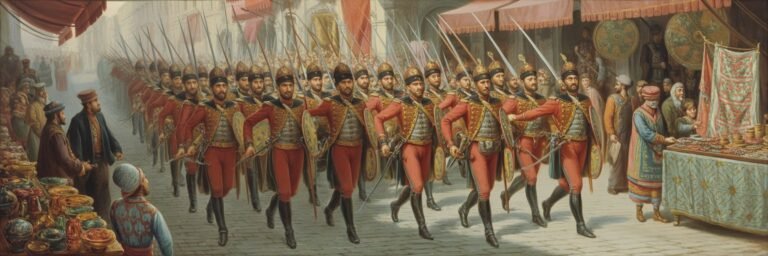INTRODUCTION
The centuries-long span of the Ottoman Empire left an indelible mark on the pages of history. This stunning civilization, with its roots dating back to 1299, was not just a geographic and military presence; it was a cradle of culture and innovation that influenced the world in ways both profound and surprising. This article unfurls the intricate, unknowingly rich tapestry of the Ottoman Empire’s story, weaving together scholarly analysis, cultural insights, and a splash of mystery.
HISTORICAL BACKGROUND
The rise of the Ottoman Empire was a monumental saga of power, religion, and conquest. The Empire was founded by Osman I, a leader of the Anatolian beyliks, small Turkish principalities in the frontier region of the Byzantine Empire. Under Seljuq suzerainty, these beyliks welded an effective military and political structure which paved the way for the Empire’s development. By the late 15th century, the Ottomans had established themselves as a formidable power, seizing Constantinople in 1453 under Mehmed the Conqueror, a significant victory that marked the end of the Byzantine Empire.
THEORIES AND INTERPRETATIONS
The rise of the Ottoman Empire has been studied through various lenses over the centuries. Some scholars attribute its success to their effective military administration, a mixture of nomadic cavalry and infantry which gave them an edge in warfare. They mastered gunpowder technology and had a sophisticated logistical system, drawing strength from their spirit of ghaza, or holy war. Another interpretation pivots on the Empire’s placement along crucial trade routes, which allowed the Ottomans to function as middlemen between East and West.
A less mainstream theory argues that the Empire flourished due to the balance they struck between centralization and regional autonomy. The millet system, for example, permitted religious and ethnic communities to govern themselves with some restrictions, thus managing the Empire’s diversity to an extent.
MYSTERIES AND CONTROVERSIES
The Ottoman Empire was not without its share of intriguing puzzles and controversies. One of the enduring mysteries surrounds the fate of the famed Ottoman navy admiral, Piri Reis. The loss of his final expedition in 1554 sparked theories ranging from mutiny to encounters with European forces.
There’s also a simmering controversy around the role of concubines and eunuchs in the Ottoman palace. The harem, often stigmatised in Western discourse as a realm of sexual indulgence, actually functioned more as a complex power centre. Sultan’s concubines, some of whom rose to wield great political influence, and the eunuchs who guarded them, played crucial roles in the Empire’s politics.
SYMBOLISM AND CULTURAL SIGNIFICANCE
Turkish bathhouses, or hammams, stand as potent symbols of the Ottoman Empire. More than places for hygiene, these communal spaces were forums for socialisation, relaxation, and ceremony.
The role of coffee also cannot be overstated. Introduced in the early 16th century, it became a staple of daily life, prompting the emergence of coffeehouses – hotbeds for intellectual discussion and political debate.
Another significant cultural symbol was the fez hat, introduced by Sultan Mahmud II in an attempt to modernise traditional clothing. Ironically, its banning in 1925 by Mustafa Kemal Atatürk as part of his modernisation efforts after the Empire’s fall has made it an emblem of Ottoman nostalgia.
MODERN INVESTIGATIONS
Modern researchers continue to delve into the annals of the Ottoman Empire, unearthing surprising finds. Archival work, for instance, uncovered court records showing a surprisingly modern system of justice, with detailed laws regarding property rights, contracts, and even environmental regulations.
Technological innovations, like Geographic Information System (GIS) mapping, have enabled historians to study the spatial layout of the Empire in detail. These explorations revealed that the urban planning of several Ottoman cities was often environmentally conscious, revolving around waterways and green spaces, underlining the Empire’s profound understanding of ecology.
LEISURE AND CONCLUSION
The Ottoman Empire’s role in shaping history is undeniable. Few empires have left such a mark in so many ways – from coffee culture to poetry, from architecture to legal systems. Even their mistakes, errors and failures give us a glimpse into a complex civilisation grappling with modernity.
What is fascinating about the Ottomans is not just their impressive geographical and temporal span, nor their memorable rulers or military exploits. What truly stands out is how they significantly influenced the medieval world and continue to resonate today. Whether through crafting the first coffeehouses or navigating the fragile balance of religious diversity, the Ottomans managed to forge an inimitable identity.
No history of the world is complete without tipping a hat – perhaps a red fez – to the six centuries of cultural, political, and economic unfolding brought forth by the Ottoman Empire. A deep dive into their history unveils their impact – not only in shaping the Middle East or the Islamic world, but also in sculpting the very contours of global history. This is a testament to the indomitable spirit of a people who rose from a small Anatolian tribe to transform into a formidable world Empire. We continue to unravel the many layers of their existence, but perhaps, equally as important, we continue to live in a world that was in many ways defined by their legacy.






